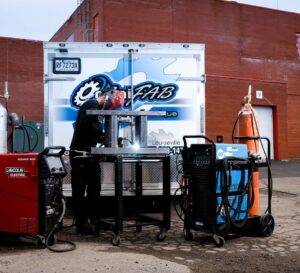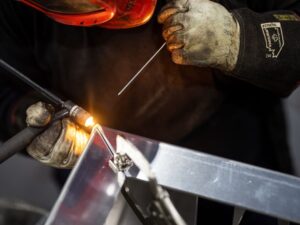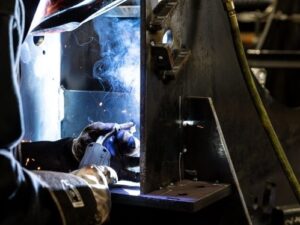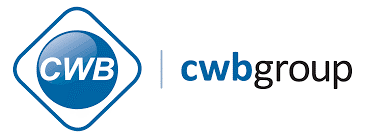“Know all about arc welding” — a title proving that our seasoned welding team doesn’t hesitate to share their knowledge on subjects closely related to their work. That’s what it means to have a passion for their trade!
In this extensive article, divided into different themes, you will find a wealth of information about arc welding. All content is approved by specialists in the field
1 – Principles of Arc Welding
Arc welding is named as such because it relies on the creation of an electric arc between an electrode and the workpieces to be welded. During arc welding, electrical current is used to generate the necessary heat to melt the metals and form a strong weld joint between the pieces.
Arc Welding Process
The arc welding process is based on several fundamental elements:
1 – Power Source
To generate the electric arc essential for the welding process, an electrical power source is necessary. This current can be supplied by different types of welding machines such as electric arc welders, welding generators, or other similar devices.
2 – Electrode
The electrode is a piece of conductive metal used to establish the electric arc. Depending on the type of arc welding chosen, the electrode can be consumable (as in manual arc welding) or non-consumable (as in TIG welding).
3 – Electrical Circuit
When the electrode is connected to the power source, an electrical circuit is created. As the electrode is brought close to the metal pieces to be welded and the electric arc is initiated, an electrical current flows through the electrode, the arc, and the workpieces.
4 – Heat Generation
As the electrical current passes through the arc, it encounters resistance in the metal, generating a significant amount of heat. This intense heat melts the base metal and the electrode (in the case of consumable electrodes), forming the weld joint.
5 – Arc and Weld Pool Protection
To protect the arc and the weld pool from oxidation and contamination by air, different gases or fluxes can be used, depending on the arc welding process.
Compatible Materials
Here is a non-exhaustive list of materials that can be welded using arc welding. Keep in mind that there are different types of arc welding (which we will list below), and some are better suited for specific metals.
- Steel (carbon steel, stainless steel, alloy steel)
- Cast iron
- Aluminum
- Copper and copper alloys
- Nickel and nickel alloys
- Titanium
Benefits of Arc Welding
Arc welding offers several advantages that make it one of the most commonly used welding methods in various industrial applications.
Versatile
As mentioned earlier, arc welding can be used to weld a wide variety of metals, making it an effective welding method for many applications.
Economical
Among welding methods, arc welding is generally the most affordable option in terms of equipment and consumable costs.
Suitable for Mobile Welding
Arc welding equipment is available in portable versions that can be easily transported to job sites or factories for mobile welding tasks.
What’s more, arc welding can be performed in various positions, including flat, vertical, horizontal, and even overhead, making it suitable for a wide range of on-site welding jobs.
High quality
When performed by a skilled and experienced welder, arc welding can produce high-quality welds with good penetration, high mechanical strength, and metallurgical characteristics that meet the standards of many industries
Applications
Arc welding plays an essential role in many industries:
Mechanical fabrication
The assembly of machines and other industrial equipment (such as conveyors, lifting equipment, etc.) is often done using arc welding.
Industrial Mechanics
Many repairs of industrial machines or heavy equipment require arc welding work. Therefore, this type of welding is frequently used in industrial mechanics, both in factories and on-site.
Construction
Many buildings and structures (such as bridges, viaducts, etc.) have metal frameworks or components assembled using arc welding.
Automotive, Marine, and Aerospace Industries
Countless mechanical parts of cars, trucks, boats, and airplanes are crafted using arc welding at some point. The chassis of many of these vehicles and devices are also assembled with this technique.
Oil, Gas, and Petrochemical Industries
In these sectors, a vast amount of pipelines, tanks, and reservoirs are made of metal and assembled using arc welding.
Agricultural and Food Industries
Arc welding is widely used in the manufacturing of agricultural machinery. The same applies to equipment used in food processing plants, whether it’s vessels, packaging machines, or other equipment.
Mining and Metallurgical Industries
In mines and aluminum smelters, in particular, many pieces of equipment are assembled, repaired, or even reinforced using arc welding.
And Many More
Do you need help for a welding Project?
2 – Types of Arc Welding
There are different types of arc welding. They may have different names and uses, but all share the common principle of being based on the creation of an electric arc.
Gas Tungsten Arc Welding (GTAW (TIG), GTAW)
This type of welding uses a non-consumable tungsten electrode (or an alloy of tungsten), where filler metal is often used separately. An inert gas is also used to protect the weld area, hence the name TIG for “Tungsten Inert Gas.”
This welding method is ideal for assembling thin sheet metal and does not contaminate the base metal.
Gas Metal Arc Welding (GMAW, MIG)
Gas metal arc welding, also known as GMAW, is a semi-automatic welding process. During this process, the fusion of metals is achieved through the heat generated by an electric arc formed between the workpieces and a consumable metal wire electrode.
This process is referred to as “gas metal arc welding” because a shielding welding gas is continuously fed over the arc during welding. This effectively isolates the molten metal from the surrounding air and its contaminants.
This type of arc welding is a logical choice when the goal is to achieve very thick weld beads and/or high productivity.
Shielded Metal Arc Welding (SMAW)
Shielded metal arc welding, also known as SMAW, is a manual welding process that uses electrodes coated with a coating (flux).
Under the heat generated by the electric arc, both the electrode and the metal melt. The power of the arc guides the molten filler metal towards the weld pool, forming the weld bead. Simultaneously, the heat from the arc melts the flux, creating a solid layer that protects the weld from atmospheric gases that could compromise its quality.
This process is widely used for welding pipeline systems and piping networks.
Flux-cored Arc Welding (FCA-W)
In this type of welding, the electrode is a tube filled with flux, giving it the name “flux-cored welding.” During the operation, the flux melts and forms a slag that covers and protects the weld from the surrounding air, even in windy conditions.
This makes the process particularly suitable for outdoor welding tasks, as it also allows for high-speed welding.
3 – Electric Arc Welding Equipment
To perform arc welding, a variety of basic equipment and accessories are required to ensure the efficiency and safety of the process:
Welding Power Source:
This function is usually carried out by a welding unit selected according to the type of welding to be performed.
Welding Electrodes:
For manual arc welding (SMAW), coated electrodes are required. For other types of arc welding, appropriate wire electrodes are necessary.
Wire Brush:
A brush with metal bristles is useful for cleaning surfaces to be welded and removing flux residues or dirt.
Ground Clamp:
This clamp must be connected to the material being welded to create a complete electrical circuit with the electrode.
Electrode Holder Clamp:
This clamp is used to hold and manipulate the electrode during manual arc welding.
Shielding Gas (for MIG/TIG welding):
If you are performing gas-shielded arc welding, you will need an appropriate gas cylinder to protect the weld pool.
Protective Equipment
Welding Helmet: It protects the eyes and face from intense light flashes and sparks generated during welding.
Welding Gloves: They protect the hands from burns and sparks.
Protective Clothing: Clothing resistant to flames and molten metal projections is recommended during welding. A leather apron can also be worn over clothing.
Safety Glasses: They protect the eyes from debris and metal projections.
4 – Step-by-Step Guide to Arc Welding
Arc welding requires good equipment, a methodical approach, and technical skills. If you think you’re up to the task, here are the key steps to perform arc welding:
1 – Preparing the Welding Area:
Make sure the surfaces to be welded are clean, free of any dirt, rust, paint or other contaminants. Also remove any smudges and ensure that parts are correctly positioned.
2 – Choosing the Equipment and Consumables:
Select the appropriate welding machine and electrode based on the materials to be welded and the welding specifications.
3 – Setting Up the Welding Machine:
Adjust the welding power on the machine according to the recommended specifications for the type and thickness of the materials to be welded.
4 – Setting Up Safety Equipment:
Wear adequate protective equipment, including a welding helmet with the appropriate filter lens, protective gloves, a flame-resistant apron, and spark-resistant clothing.
5 – Arc Ignition:
Hold the electrode at an angle of about 10 to 15 degrees to the surface to be welded. Bring the electrode close to the part and initiate the arc by touching the surface, then quickly pulling it away. This creates the electric arc.
6 – Weld Bead Formation:
Once the arc has been ignited, move the electrode along the weld joint at a steady, even pace. Ensure to maintain the correct arc length for proper metal penetration and fusion.
7 – Filler metal deposition:
If necessary, add filler metal by melting it along the weld bead to ensure adequate fusion between the parts being welded.
8 – Cooling and Cleaning:
Once welding is complete, switch off the arc and allow the weld zone to cool. Clean the weld area using a wire brush to remove any flux or slag residue, if needed.
9 – Weld Inspection:
Visually examine the weld for defects such as porosity, cracks or deformation. If necessary, have a weld inspection carried out by a welding expert to certify compliance.
5- Choosing Your Arc Welder
If you’re looking for an arc welder, you should know that you can ensure you get a professional service by doing a few simple searches:
Achievements
It’s always best to entrust your welding projects to a welder who has already completed similar mandates. In this light, don’t hesitate to ask for examples of welding accomplishments from the companies you’re considering hiring.
Formation
Although it’s possible to learn the basics of arc welding “on the job” or in-house, formal training is often a guarantee of good results. In Quebec, there are various academic welding programs, such as the DEP in Welding and Fitting and Welding Assembly.
Accreditation
Another way to ensure work that meets your expectations is to choose an accredited welding service provider. For instance, you can look for companies with this certification:
- CSA Standard W47.1 – Certification of Companies for Fusion Welding of Steel
6- Omnifab: Delivering Impeccable Welding Services in the Shortest Turnaround Times
As you’ve read through this text, you’ve likely realized that arc welding requires both advanced skills and specialized tools. With that in mind, before entrusting a welding project to a subcontractor, it’s crucial to ensure that their personnel are well-trained and equipped to meet your specific needs.
At Omnifab, our welders possess the necessary expertise to guarantee robust, durable, and aesthetically pleasing welds, whether it’s within our facility or on-site using our mobile welding unit.
Don’t hesitate to reach out to us, we’ll tailor welding solutions perfectly suited to your project.








